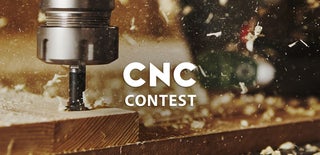Introduction: Mirror Frame Carved With CNC
With this instructable I want to tell how I made a mirror frame with my self-built CNC.
Nice experience and also very demanding ...
Everything starts from the 3D model that to speed things up a bit I bought for $ 2.99 on one of the many sites that sell .STL models of frames.
Once I downloaded the model and imported it into Rhino I had to adapt it in terms of measurements to the working extensions of my CNC Raptor and scaled in height to fit it in a thickness of 19mm.
The thing I regretted was using MDF as a support, easy to work with but very difficult to paint.
The quality of the 3D model is good there is to consider that with the milling a little detail is lost because the tip of the finishing cutter even if small (3 mm) will never be able to pass into the narrowest slots unless you uses a burin but then the milling times will make an x10.
Another bit of detail is lost during sanding so if the 3d model is not qualitatively good in terms of the number of faces it is not a big problem.
Step 1: 3D Modeling, CAM Configuration and Tool Path Setting
My Raptor CNC worktop touches 1450 mm but to be on the safe side I preferred to reduce the model further down to 1294x761 mm.
Exported to .STL from Rhino I imported it into Aspire to define the toolpaths for roughing and finishing.
For roughing I used a 6mm single-headed flat-carbide cutter in carbide because it is known that MDF consumes them very quickly. For the finish I used a ball cutter diam. 3 mm.
Regarding the finish I had to make a choice:
make a very precise processing and then let the cnc work for more than 80 hours in a row or make a lower quality and then sand and uniform the pass lines.
The choice went to the second, lower quality milling and then sanding which in any case must be done because the prototype is unlikely to come out ready for painting.
I then set the side step of the cutter to 0.2 mm
I attach the roughing and finishing Gcode files and the ready-made project in Aspire v4
Step 2: Milling...
Although I have chosen to stay on a medium-low quality, the estimated processing times are very high, around 36 hours.
Not wanting to control the CNC for 36 straight hours, I made sure to resume work over several days by making the zero point very precise at each session start.
The bad thing about the MDF is that it consumes the cutters quickly and after about 2 hours of work they lose their sharpening and start tearing, I tried with different speeds and rotations but the result did not change at all.
The roughing phase took slightly less than that estimated by the software about 9 hours which I divided into 3 days of 3 hours of work on the other hand, it required much more finishing for atotal of 34 hours and 27 minutes of milling.
The finish, on the other hand, was a bit more demanding because the resumption of work and the zero piece, however precise, generates a slight recovery line so I tried to do it in just 2 sessions.
After the two finishing sessions I made the central cut.
Step 3: Sanding ...and Lots of Patience
The sanding work is the most exhausting one because it initially serves to standardize the model by eliminating the traces of the cutter then it must be repeated 3 more times after the base coats.
For each sanding coat it took 3 1/2 hours, and I did it 4 times: - (((
The very annoying thing about MDF above all is that at the first base coat, all the hair is raised, it looked like a kiwi.
After hours and hours of sandpaper and 3 other coats, the hair of the wood stopped rising and I finally started to see the dim light at the bottom of the tunnel.
Step 4: Final Painting
Finally it's time for the final painting of the color that I had also chosen to paint the living room furniture that I made a white RAL 9010 a few weeks ago.
Eliminating all the imperfections of the MDF is impossible (for me), I tried to do my best but some small defect remained, patience ...
Step 5: Rear Support for the Mirror
Lastly, I made a simple support to be screwed into the back of the frame to hold the mirror.
I cut 4 strips of plywood 7 cm wide and 12 mm thick. on each of them I made a 4mm groove to accommodate the mirror.
Step 6: It's Time to Hang It on the Wall
After a lot of work, a lot of patience and a lot of perseverance this is the result obtained, my wife is satisfied and this is the important thing.

Participated in the
CNC Contest 2020














